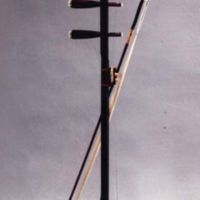Erhu 二胡
Dublin Core
Title
Erhu 二胡
Subject
Chinese music, Sound, Craft
Description
The erhu is a bowed spike-lute chordophone of the Han Chinese (‘er’ means two; ‘hu’ originally meant ‘barbarian,’ but now ‘fiddle’).
Date
Tang Dynasty (618-907 AD)
Format
Wooden
Type
Craft
Crafts Item Type Metadata
Crafting Methods
The long, round, hardwood neck of the erhu runs through its constructed hexagonal wooden resonating chamber the front of which is covered by a snakeskin soundboard (affixed by glue). The backside of the resonator is open but adorned with a carved wooden screen. White plastic or bone caps adorn both the curved top end of the neck and the ends of the two friction tuning pegs, which are inserted through the backside of the neck. A red velvet cushion is fixed to the bottom of the resonator. One end of each steel string is attached to and wrapped around a tuning peg, the other end terminates in a noose that is looped over a metal tail pin on the bottom side of the resonator. The top end of the vibrating segment of the strings is articulated with an adjustable sliding nut (called qianjin) of nylon cord; the lower end of the vibrating segment is where the strings pass over a small wooden bridge on the soundboard. The bow is made of bamboo – however, a Western bow hair-tightening mechanism has been attached, making unnecessary the established technique of holding the bow hair taut while playing the instrument.
Materials
Wood, Metal, Horsehair
Usage and Application
It is used as one of the main melodic instruments for accompaniment of Beijing opera performance and in regional instrumental ensembles.
Collection
Citation
“Erhu 二胡,” CCCH9051 Group 64, accessed July 2, 2025, https://learning.hku.hk/ccch9051/group-64/items/show/27.


